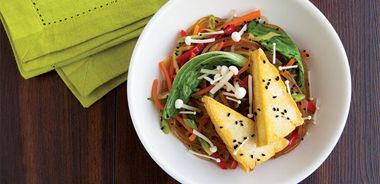Japchae with Tofu Steaks

In simple terms, Japchae is a Korean dish consisting of plenty of vegetables served with springy sweet potato noodles. Long, slender enoki mushrooms provide a fanciful garnish. If you can’t find these noodles or the Korean hot pepper paste called gochujang, you can use soba noodles and a different Asian chili sauce, such as Sriracha. This dish is equally good hot or cold.
1 pkg (350 g) organic extra-firm tofu
10 oz (285 g) sweet potato noodles
2 Tbsp (30 mL) low-sodium soy sauce
1 Tbsp (15 mL) gochujang (Korean red chili paste)
1 Tbsp (15 mL) sesame oil
1 Tbsp (15 mL) mirin or rice vinegar
4 or 5 baby bok choy
2 Tbsp (30 mL) grapeseed oil or peanut oil
1 carrot, sliced into matchsticks
1 red bell pepper, thinly sliced
2 garlic cloves, thinly sliced
3 green onions, white and green parts, thinly sliced
3 oz (85 g) enoki mushrooms, ends trimmed
1 Tbsp (15 mL) black sesame seeds
Place several sheets of paper towel on cutting board and place tofu on top of sheets. Top tofu with more paper towels and place heavy object on top. Let water drain from tofu for 10 minutes. Cut tofu crosswise into 7 equal-sized pieces, then cut each piece in half on diagonal, making a triangle.
Cook sweet potato noodles in large pot of boiling water for 5 minutes, or until tender, stirring often for the first minute. Be sure not to overcook or noodles will lose their chewy texture. Immediately drain and rinse thoroughly under cold water. Cut the bunch of noodles in half and set aside.
In small bowl, whisk together soy sauce, gochujang, sesame oil, and mirin or rice vinegar; set aside.
Separate bok choy leafy tops from stalks, roughly chop leaves, and thinly slice stalks.
Heat grapeseed or peanut oil in wok or large skillet over medium-high heat. Add tofu and cook for 3 to 4 minutes per side, or until golden brown. Remove tofu from pan and place on paper towels. Add carrot, bell pepper, bok choy stalks, and garlic to pan; cook until slightly tender, about 3 minutes. Stir in noodles, sauce, bok choy greens, and green onions; heat through.
Divide noodle mixture among serving bowls and top with tofu, enoki mushrooms, and sesame seeds.
Serves 6.
Each serving contains: 333 calories; 10 g protein; 11 g total fat (1 g sat. fat, 0 g trans fat); 50 g total carbohydrates (12 g sugars, 3 g fibre); 353 mg sodium
Source: "Oodles of Noodles", alive #377, March 2014





